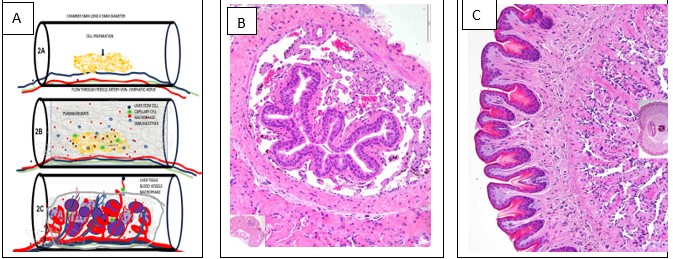World first: Micro-organ grown from adult stem cells in vivo
Tissue engineering is an exciting new area of medical research led by Dr Aurora Messina, Senior Research Fellow (Morphology) at the Department of Medicine at Royal Melbourne Hospital.
 Image created by Dr Aurora Messina and Professor Mary Galea (Department of Medicine), & Professor Elizabeth Vincan and Dr Bang Tran (Department of Infectious Diseases)
Image created by Dr Aurora Messina and Professor Mary Galea (Department of Medicine), & Professor Elizabeth Vincan and Dr Bang Tran (Department of Infectious Diseases)
Engineering organ-like micro-tissues is done with the aim to create ‘surrogate’ tissues that can be used to repair, replace, or support failing organs. The team has developed a unique method for growing adult-derived stem cell organoids in an in-vivo tissue engineering chamber, where they can develop.
The chamber is constructed by wrapping a silicone tube around a vascular pedicle (artery, vein and nerve) (A-top) that spontaneously generates a plasm/cell rich exudate (A middle) and sprouts new blood vessels (A bottom) that provides oxygen and nutrients. Over time the pedicle generates all levels of the vascular tree which develops and integrates with the stem cells to form micro-tissues but remains connected to the mouse circulation.
We have successfully grown micro-tissue (10mm long and 3mm diameter) that demonstrates an extraordinary degree of blood vessel growth or ‘vascularisation’ and organisation and includes many tissue types including skin (B), lung (B, C), muscle (B), cartilage (not shown), bronchiole (B) and alveolar like tissue (B, C). This is the first example of an organised, vascularised, micro-tissue grown from adult stem cells, that persists for at least 9 weeks. Significantly this micro-tissue grows without extraneous matrices or scaffolds or added growth factors. It is suitable for human in vivo translation by substituting adult patient derived stem cells. Our novel technique for generating micro-tissues can be applied to generate micro-tissue that support wound healing, reverse diabetes and support a failing liver.